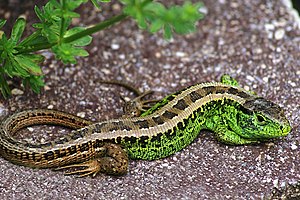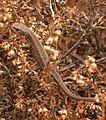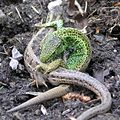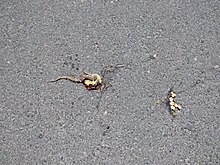Sand lizard
| Sand lizard | ||||||||||||
|---|---|---|---|---|---|---|---|---|---|---|---|---|

Sand lizard ( Lacerta agilis ), male |
||||||||||||
| Systematics | ||||||||||||
|
||||||||||||
| Scientific name | ||||||||||||
| Lacerta agilis | ||||||||||||
| Linnaeus , 1758 |
The sand lizard ( Lacerta agilis ) is a reptile from the family of the real lizards (Lacertidae) that is widespread especially in Central and Eastern Europe and Western Asia .
features
In German-speaking countries, sand lizards reach a total length of around 24 cm. Particularly large animals have head-trunk lengths of around 9.5 cm and tail lengths of around 14 cm. The largest known head-torso length of 11.5 cm comes from a sand lizard from the Caucasus. In general, the females have longer bodies, while the males have longer heads and slightly longer tails. Compared to the forest lizard and the wall lizard, the animal looks clumsier and much stronger. The sides of the snout are steep and high and end blunted towards the front. The skull is flattened and delimited from the sides by an edge that extends from the eyes to the nostrils. The back of the head is slightly wider than the neck and is therefore separated from it. The tail is much higher at its root than it is wide and gradually tapers; the tip is not drawn out very long. (A regrown, regenerated tail is usually much shorter and less marked.)
The coloring and drawing is very variable depending on the individual, gender, age and season (males!). Often there is a “ladder-like” pattern on the center of the back and tail, made up of light lateral lines (parietal ligaments) and dark brown “cross bars” (dorsal spots) with brown spaces. In the center and laterally over the dorsal spots there are also mostly whitish, interrupted longitudinal lines (occipital line and parietal lines). The basic color of the skull, tail and limbs is also brown and the spots on the flanks are also white. During the mating season (until June / July) the males show green colored head, torso and belly sides; especially in south-west Germany there are also animals that appear almost entirely green. Another specialty are red-backed specimens. The underside of the females is yellowish and blotchless, while the males are green with black spots. The young are brown in color, often with noticeable eye spots on the back and sides.
Way of life
In Central Europe, wintering begins as soon as sufficient energy reserves have been created. Adult males usually disappear at the beginning of August, the females in September, young animals withdraw in September or October. From the beginning of March, the young and / or the males and a few weeks later the females appear on the surface. If the weather is nice, sunbathing is done in the morning to bring the cold-blooded ( poikilothermal ) organism to "operating temperature". Then the animals go in search of food. The range of prey includes mainly insects such as grasshoppers , cicadas , beetles and their larvae, bedbugs, ants, spiders and earthworms. They drink from drops of dew and raindrops. Sand lizards hide in their hiding places when it is very hot, bad weather or at night.
Their natural enemies include many birds and mammals, but also other reptiles. They are hunted by birds of prey , corvids , starlings , pheasants , blackbirds , martens , foxes , hedgehogs and smooth snakes . The eggs are eaten by mole crickets and ground beetles , among others . A particular threat from stray domestic cats is often mentioned. However, there is no evidence for this, and the main areas of distribution of the sand lizard in areas with loose residential buildings speak against it. On the other hand, there is evidence of endangerment from pheasants, which are often released in large quantities. Wild boars can destroy hibernation areas through their burrowing activity, but this also creates open areas and egg-laying areas. When threatened, the lizard can shed part of its tail at one of several “ predetermined breaking points ” so that the enemy is distracted from the twitching appendage. Later the tail forms anew; however, it then remains shorter.
Reproduction
After the first molt (in Central Europe around the end of April), the mating season begins and lasts until the end of June. If males meet, ritualized threatening and imposing gestures ( comment fights ) can occur. If the female does not feel ready to mate, it bites the male and tries to keep it away. When mating, the male first grabs the middle of the tail of the female with its jaws. It then bites its flank and bends its body so that the cloaca of both animals meet and the hemipenis can be inserted. This union lasts three to five minutes and is carried out several times in a row.
The eggs are laid from the middle of May to the end of July, occasionally even in August. For this purpose, sandy places are sought that can be reached by the sun. The female digs small holes and deposits 5 to 14 soft-shelled eggs in them. The development time of the eggs in the sandy soil is strongly dependent on the ambient temperature; at 21 to 24 ° C it is two months. The hatchlings are about 5-6 cm long. Freshly hatched, they must also be careful of their own parents to avoid being eaten. They reach sexual maturity after one and a half to two years. In exceptional cases, sexual maturity can be reached after the first winter with one year.
A male follows the female until she is ready to mate
habitat
Sand lizards are anthropogenically oriented organisms in terms of their habitat structures. They colonize lean biotopes such as dry forest edges, railway embankments, heathland, dunes, quarries, gravel pits, wild gardens and similar habitats with an alternation of open, loosely-grounded sections and more densely vegetated areas. In cooler areas, the occurrence is limited to heat-favored locations. Elements such as dead wood and old grass are also important.
distribution
The distribution area extends from central France over all of Central and Eastern Europe and southern Sweden, over the Baltic States, Lake Ladoga and Onega to the southern tip of Lake Baikal in the far east. The British main island is only inhabited selectively in the south. The southern area boundary is formed by the Pyrenees , the northern capping of the Alps , the south of the Balkan Peninsula and the Caucasus . Northern and central Scandinavia, Scotland and Ireland and largely the Mediterranean area are not populated.
In the north of its range, the sand lizard lives mainly in flat and hilly areas. At the southern edge of their area, however, the species can only be found in higher mountain regions; the altitude distribution in the south reaches 2000 meters above sea level in places. The southernmost occurrence of the species is in the Greek Pindos Mountains .
Danger
Populations of the sand lizard are being decimated mainly through the destruction of habitats and small structures in the landscape. These include, for example, the recultivation of so-called “wasteland”, the re-cultivation of fallow land, the loss of marginal strips and embankments, general intensive agriculture or the fragmentation of the landscape through road construction or traffic and settlement construction.
In the course of construction work, it may be necessary to relocate sand lizards. Laufer (2014) provides instructions for this .
Legal protection status (selection)
- Habitats Directive : Annex IV (species to be strictly protected)
- Federal Nature Conservation Act (BNatSchG): strictly protected
National Red List classifications (selection)
- Red List Federal Republic of Germany: V - Warning List
- Red list of Austria: NT (endangerment threat; warning list)
- Switzerland's red list: VU (endangered)
particularities
The sand lizard was proclaimed “ Animal of the Year 2005” in Switzerland and “ Reptile of the Year 2020” in Germany . Sand lizards produce antibodies against Lyme disease .
swell
literature
- Dieter Glandt , Wolfgang Bischoff (Ed.): Biology and protection of the sand lizard (Lacerta agilis) = results of the symposium of the same name from February 24th to 26th, 1988 in the Biological Institute Metelen eV, Metelen / Federal Republic of Germany. = Biology and conservation of the sand lizard (Lacerta agilis) (= Mertensiella. Volume 1). Ziegan, Berlin 1988, ISBN 3-9801929-0-3 .
- Kerstin Elbing, Rainer Günther, Ulf Rahmel: Sand lizard - Lacerta agilis, Linnaeus, 1758. In: Rainer Günther (ed.): The amphibians and reptiles of Germany. Gustav Fischer, Jena et al. 1996, ISBN 3-437-35016-1 , pp. 535-557.
- Ina Blanke: The sand lizard. Between light and shadow (= magazine for field herpetology. Supplement 7). 2nd, updated and supplemented edition. Laurenti, Bochum 2010, ISBN 978-3-933066-43-5 .
- Ina Blanke, Helen Fearnley: The sand lizard between light and shadow . Updated and supplemented international edition. Laurenti, Bielefeld 2015, ISBN 978-3-933066-55-8 .
Individual evidence
- ↑ Hubert Laufer (2014): Practice-oriented implementation of strict species protection using the example of sand lizards in Naturschutzinfo 1/2014 (LUBW): http://www4.lubw.baden-wuerttemberg.de/servlet/is/240091/naturschutz_info_2014_1.pdf?command = downloadContent & filename = naturschutz_info_2014_1.pdf
- ↑ Sand Lizard at www.wisia.de
- ↑ Klaus-Detlef Kühnel, Arno Geiger, Hubert Laufer, Richard Podloucky , Martin Schlüpmann: Red List and List of Total Species of Reptiles of Germany. In: Federal Agency for Nature Conservation (Ed.): Red list of endangered animals, plants and fungi in Germany. Volume 1: Vertebrates (= nature conservation and biological diversity. 70, 1). Federal Agency for Nature Conservation et al., Bonn-Bad Godesberg et al. 2009, ISBN 978-3-7843-5033-2 , pp. 231–256, digital version (PDF; 1.41 MB) .
- ↑ Online overview at www.amphibienschutz.de
- ↑ Page no longer available , search in web archives: Red List Reptiles of Switzerland, 2005 (pdf, download)
- ↑ http://www.schwarzwaelder-bote.de/inhalt.hausach-oekologe-strassen-sind-amphibienkiller.4d602c03-6f3c-4ad1-b7a8-1df320474f6e.html
Web links
- Lacerta agilis inthe IUCN 2013 Red List of Endangered Species . Posted by: Agasyan, A., Avci, A., Tuniyev, B., Lymberakis, P., Andrén, C., Cogalniceanu, D., Wilkinson, J., Ananjeva, N., Üzüm, N., Orlov, N., Podloucky, R., Tuniyev, S., Kaya, U., Crnobrnja Isailovic, J., Vogrin, M., Corti, C., Pérez Mellado, V., Sá-Sousa, P., Cheylan, M ., Pleguezuelos, J., Kyek, M., Westerström, A., Nettmann, HK, Borczyk, B., Sterijovski, B. & Schmidt, B., 2010. Retrieved September 3, 2013.
- Photos of the sand lizard at www.herp.it
- Distribution map at the SEH (jpeg; 1111 kB)
- Sand lizard Lacerta agilis (LINNAEUS, 1758) ( Memento from June 26, 2012 in the Internet Archive )
- Sand lizard at www.reptilien-brauchen-freunde.de
- Photos and tips for protecting sand lizards in your own garden and public green spaces at BUND Darmstadt
- Lacerta agilis in The Reptile Database












